Click below to jump to an article of interest.
Airborne SLED to Detect Methane Leaks
SwRI’s methane leak detection system is taking flight as part of a U.S. Department of Energy (DOE) National Energy Technology Laboratory (NETL) project to automate inspections of oil and gas facilities. SwRI researchers are adapting the Smart LEak Detection System/Methane (SLED/M) technology to detect methane leaks in real time from aboard a drone. SLED technology, winner of an R&D 100 Award in 2017, uses cameras and artificial intelligence to detect liquid hydrocarbon leaks on pipelines and facilities such as pump stations. SwRI then developed SLED/M to detect gaseous leaks with DOE NETL funding.
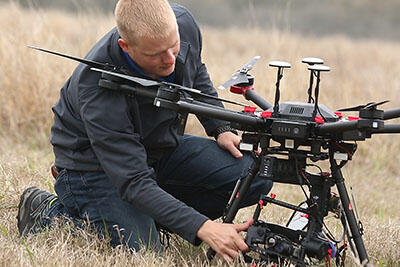
SwRI Engineer Heath Spidle prepares a drone outfitted with technology designed to autonomously detect methane leaks.
“After successfully developing SLED/M for stationary applications, such as fence-line monitoring of midstream facilities, we are advancing the technology to perform autonomously from drones,” said SwRI Engineer Heath Spidle.
The system identifies small methane leaks, known as fugitive emissions, by pairing passive optical sensing data with artificial intelligence algorithms. The new NETL project will enable SwRI to collect data, test midwave infrared cameras (MWIR) on drone flights and develop machine learning algorithms to detect methane leaks.
“This drone/camera configuration presents unique challenges because it captures data at different heights, distances and speeds,” Spidle added. “This funding enables development and testing to adapt the technology for commercial aerial inspections.”
SwRI designed SLED/M to pinpoint small methane leaks that typically go unnoticed along pipelines and storage facilities. Conventional detection systems, designed to locate larger leaks, suffer from false positives and missed detections, which hamper effectiveness and utilization by industry. By optimizing algorithms to reliably detect leaks under a variety of environmental conditions, SLED/M substantially reduces false positives and discovers leaks that might otherwise go unnoticed.
The project also leverages SwRI’s ongoing research into unmanned aerial systems (UAS), drone automation, navigation, perception and data analytics. Recent drone innovations include adapting technology to autonomously inspect damaged nuclear reactors and other hazardous facilities.
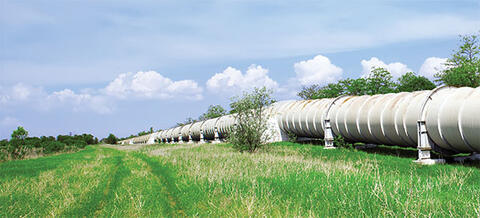
“SwRI’s R&D investment in drone payloads and analytics aligns with our mission to advance science and technology that benefits government, industry and humankind,” said Dr. Steve Dellenback, vice president of SwRI’s Intelligent Systems Division. “This effort is helping address a significant challenge facing the world right now.”
Methane, the main component in natural gas, is considered a more threatening greenhouse gas than carbon dioxide because it absorbs heat more effectively. The World Meteorological Organization recently reported that methane levels are 2.5 times higher than in pre-industrial times.
SwRI is addressing methane leaks from multiple directions. A team of fluids engineers participated in the Methane Detectors Challenge, developing a solar-powered system to identify fugitive emissions in the gas-producing sector as well.
SwRI is also processing satellite data from space with algorithms to identify large methane leaks from midstream facilities as well as crude oil spills on ocean surfaces.
Tricking Object Detection Technology
SwRI has developed new adversarial techniques that can make objects “invisible” to image detection systems that use deep-learning algorithms. These techniques can also trick systems into thinking they see another object or can change the location of objects. The technique is designed to mitigate vulnerabilities in automated image processing systems.

At left, Research Engineer Abe Garza displays the special imagery used to deceive object detection systems fueled by deep-learning algorithms. SwRI researchers are developing techniques to mitigate risks associated with these systems.
“Deep-learning neural networks are highly effective at many tasks,” says Abe Garza of the SwRI Intelligent Systems Division. “However, deep learning was adopted so quickly that the security implications of these algorithms weren’t fully considered.”
Deep-learning algorithms excel at using shapes and colors to recognize the differences between humans and animals or cars and trucks, for example. These systems reliably detect objects under an array of conditions and, as such, are used in myriad applications and industries, often for safety-critical uses. The automotive industry uses deep-learning object detection systems on roadways for lane-assist, lane-departure and collision-avoidance technologies. These vehicles rely on cameras to detect potentially hazardous objects around them. While the image processing systems are vital for protecting lives and property, the algorithms could potentially be deceived by malicious parties.
Security researchers working in “adversarial learning” are finding and documenting vulnerabilities in various machine-learning algorithms. SwRI developed futuristic, Bohemian-style patterns that, when applied to objects or people, can trick detection systems into thinking they aren’t there, that they’re something else or that they’re in another location. Malicious parties could place these patterns near roadways, potentially creating chaos for vehicles equipped with object detectors.
“The first step to resolving these exploits is to test the deep-learning algorithms,” Garza said. “The team has created a framework capable of repeatedly testing these attacks against a variety of deep-learning detection programs, which will be extremely useful for developing solutions.”
To see how object detection cameras visualize the patterns, watch our video on YouTube at https://youtu.be/ylbVMMR4Eqg.
Punch: Mission to Provide 3D Images of Solar Wind
NASA has selected Southwest Research Institute to lead the “Polarimeter to Unify the Corona and Heliosphere” (PUNCH) mission, a landmark Small Explorers Program mission that will image beyond the Sun’s outer corona. PUNCH will consist of a constellation of four suitcase-sized microsatellites or “microsats” that will launch as early as 2022. The microsats will orbit the Earth in formation to study how the Sun’s atmosphere, or corona, connects with the interplanetary medium. PUNCH will provide the first global images of how the solar corona infuses the solar wind with mass and energy.
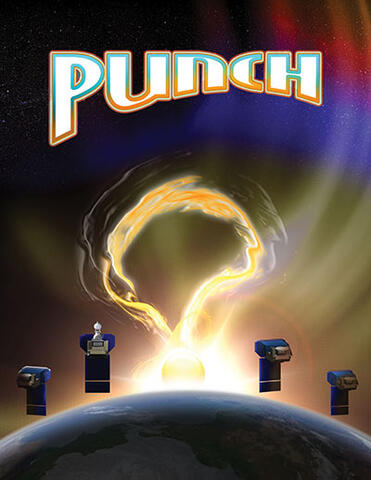
“The vacuum of space between the planets is not completely empty — it is actually filled with a tenuous, hypersonic ‘solar wind’ that streams out from the corona and affects spacecraft and planets — including our own,” said PUNCH Principal Investigator Dr. Craig DeForest, a scientist and program director in SwRI’s Space Science and Engineering Division. “PUNCH will observe the ‘no-man’s land’ between the outer solar corona and the solar wind, giving us our first clear images of the entire system connecting the Sun and Earth.”
PUNCH will track and image the solar wind as it emerges from the solar corona, transitions to interplanetary space and streams through the solar system, bathing the planets and other solar system bodies. These measurements will reveal how and why the material coming from the star becomes gusty and turbulent en route to Earth. In addition, the PUNCH satellites will track in 3D the Sun’s coronal mass ejections, also known as “CMEs” or “space storms,” as they erupt from the corona out into interplanetary space. CMEs cause some “space weather” events that affect Earth, which can threaten astronauts, damage satellites, black out power grids, and disrupt communication and GPS signals.
“Most of what we know about the space weather delivered by the solar wind comes from direct sampling by spacecraft embedded in it,” said PUNCH Project Scientist Dr. Sarah Gibson, acting director of the High Altitude Observatory in Boulder, Colorado. “This is like understanding global weather patterns based on detailed measurements from a few individual weather stations on the ground. PUNCH is more like a weather satellite that can image and track a complete storm system as it evolves across an entire region.”

SwRI developed, prototyped and environmentally tested the Wide Field Imager using SwRI internal research funding over a period of two years. The dark baffles that form the top surface of the instrument allow the wide-angle camera to image objects over a thousand times fainter than the Milky Way.
The four spacecraft will fly in a distributed formation spread around the globe, operating in sync to produce polarized images of the entire inner solar system every few minutes. Each of the four PUNCH spacecraft carries a specialized camera to capture faint glimmers of sunlight reflected by free electrons in interplanetary space. One spacecraft carries a Narrow Field Imager that captures the outer corona itself, and the others carry SwRI-developed Wide Field Imagers (WFIs). Dark baffles enable the WFIs to photograph space weather effects that are over a thousand times fainter than the Milky Way, despite flying in direct sunlight.
“Photographing the sky in polarized light is the secret sauce of the mission,” DeForest said. “When sunlight bounces off electrons, it becomes polarized. That polarization effect lets us measure how solar wind features move and evolve in three dimensions, instead of just a 2D image plane. PUNCH is the first mission with the sensitivity and polarization capability to routinely track solar wind features in 3D.”
“The Explorers Program seeks innovative ideas for small, cost-constrained missions that can help unravel the mysteries of the universe,” said Dr. Paul Hertz, director of NASA’s Astrophysics Division. “PUNCH absolutely meets the standard to solve mysteries about the Sun’s corona, the Earth’s atmosphere and magnetosphere, and the solar wind.”
The Small Explorers program provides frequent flight opportunities for world-class scientific investigations from space using innovative, efficient approaches within the heliophysics and astrophysics science areas.
For an animation of the PUNCH launch, see https://www.youtube.com/watch?v=7keLZtTIrB4
New Scouting Antenna
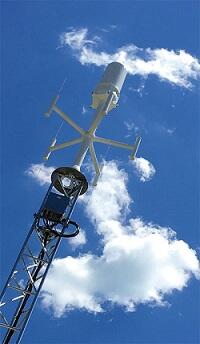
To operate safely in remote and potentially hostile parts of the world, the U.S. military collects signals intelligence, or SIGINT, detecting electronic communications, locating their source and assessing their significance to the mission at hand. Scout™ is an SwRI-developed, portable, wideband radio frequency survey and monitoring system that has aided the intelligence community for over five years.
Recently, SwRI engineers developed this AF-369 antenna to estimate the direction of the arrival of signals across the 20 MHz to 3 GHz spectrum. This fixed-site, low-cost VHF/UHF direction finding antenna augments Scout’s SIGINT collection capabilities.
LAMP Sheds Light on Lunar Water
Using the SwRI-led Lyman Alpha Mapping Project (LAMP) aboard NASA’s Lunar Reconnaissance Orbiter (LRO), scientists have observed water molecules moving around the dayside of the Moon. A paper published in Geophysical Research Letters describes how LAMP measurements of the sparse layer of molecules temporarily stuck to the lunar surface helped characterize hydration changes over the course of a day.

Courtesy of PSI/Amanda Hendrix
This graphic illustrates water molecules scattering on the lunar surface. As rough, irregularly shaped grains heat up over the course of a day, the molecules detach from the regolith and hop across the surface until they find another location cold enough to stick to.
Up until the last decade or so, scientists thought the Moon was arid, with any water existing mainly as pockets of ice in permanently shaded craters near the poles. More recently, scientists have identified surface water in sparse populations of molecules bound to the lunar soil, or regolith. The amount and locations vary based on the time of day. This water is more common at higher latitudes and tends to hop around as the surface heats up.
“This is an important new result about lunar water, a hot topic as our nation’s space program returns to a focus on lunar exploration,” said SwRI’s Dr. Kurt Retherford, the principal investigator of the LRO LAMP instrument. “We recently converted the LAMP’s light collection mode to measure reflected signals on the lunar dayside with more precision, allowing us to track more accurately where the water is and how much is present.”
Water molecules remain tightly bound to the regolith until surface temperatures peak near lunar noon. Then, molecules thermally desorb and can bounce to a nearby location that is cold enough for the molecule to stick or populate the Moon’s extremely tenuous atmosphere, or “exosphere,” until temperatures drop and the molecules return to the surface. Characterizing the water on the Moon is critical to planning future exploration.
Curing Canine Cancers
More than 100,000 dogs are affected by canine melanoma every year. SwRI has licensed its patented calcium phosphate nanoparticle delivery system exclusively to MBF Therapeutics (MBFT) to develop advanced immunotherapeutic treatments for canine melanoma.

The non-toxic, biocompatible drug delivery vehicle safely dissolves under specific conditions. MBFT will conduct clinical trials of an advanced immunotherapeutic vaccine to prevent and treat cancer in “man’s best friend” and eventually other companion animals and livestock.
“We have successfully encapsulated various active pharmaceutical ingredients in this formulation and demonstrated controlled release,” said SwRI Senior Research Scientist Dr. Hong Dixon. “The material safely and effectively dissolves under the right conditions to directly deliver the therapeutic to its target.”
Nanoparticles can carry a positive or negative charge to deliver the therapeutic into the targeted cell. SwRI applies different surface charges to this vehicle as needed to enhance drug delivery.
“SwRI’s nanoparticles are the ideal delivery vehicles for our immunotherapeutic vaccines,” said Dr. Lorraine Keller, chief science officer of MBFT. “Beyond this agreement, we look forward to working with SwRI on other projects to create effective and durable immunotherapeutic vaccines for animal health.”
Solar Advances
The U.S. Department of Energy Solar Energy Technologies Office (SETO) has awarded SwRI two concentrating solar-thermal power (CSP) research and development projects. Both will support CSP power cycles that use supercritical carbon dioxide (sCO2) as the working fluid, which has the potential to yield higher thermal efficiencies at lower costs than steam (see story about related sCO2 technology on p. 20 of this issue).
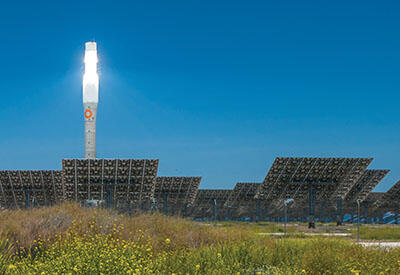
The first project, valued at \$1.5 million, will develop and test a compact dry-cooling heat exchanger for sCO2 power cycles. While dry cooling reduces the water used by power plants it can also reduce the thermal-to-electric conversion efficiency of the power cycle. The SwRI design will efficiently exchange heat between sCO2 and ambient air to conserve water and optimize peak power cycle performance.
“We’ll also test the performance and reliability of the dry cooling system within a MW-scale sCO2 test loop,” said Dr. Tim Allison, manager of Rotating Machinery Dynamics. “This concept could reduce the cooler cost from \$168 per kilowatt to \$95 per kW and reduce cooling power consumption in CSP plants by 14 percent.”
In the second project, valued at \$2 million, SwRI will develop a high-temperature dry-gas seal for sCO2 power cycle turbomachinery. CSP plants with sCO2 power cycles use mechanical seals to prevent fluid leaks. The increased temperatures and pressures of sCO2 power cycles, however, require novel materials to reach the targeted thermal-to-electric power conversion efficiency of 50 percent.
“By replacing the temperature-sensitive elements with more durable components, the new seals will withstand temperatures over 500 degrees C,” said SwRI’s Dr. Jason Wilkes. “This high-efficiency sCO2 turbine design will be smaller and simpler to improve reliability and efficiency.”
SwRI is teaming with commercial collaborators as a part of the Energy Department’s effort to invest in research to lower solar electricity costs and support a growing solar energy workforce.
KBOs Smaller Than a Mile in Diameter Are a Rarity
Using New Horizons data from the Pluto-Charon flyby in 2015, an SwRI-led team of scientists has indirectly discovered a distinct and surprising lack of very small objects in the Kuiper Belt. The evidence for the paucity of small Kuiper Belt objects (KBOs) comes from New Horizons imaging that revealed a dearth of small craters on Pluto’s largest satellite, Charon, indicating that impactors from 300 feet to 1 mile (~100 meters to 1.5 km) in diameter must also be rare.
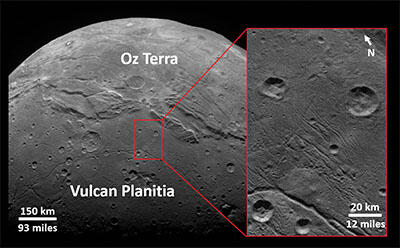
Courtesy of NASA/JHUAPL/LORRI/SwRI
An SwRI-led team studied the craters and geology on Pluto and Charon and found there were fewer small craters than expected. This implies that the Kuiper Belt contains relatively small numbers of objects less than 1 mile in diameter. Imaged by New Horizon’s LORRI camera, the smooth, geologically stable “Vulcan Planitia” on Charon illustrates these findings.
The Kuiper Belt is a donut-shaped region of icy bodies beyond the orbit of Neptune. Because small Kuiper Belt objects were some of the “feedstock” from which planets formed, this research provides new insights into how the solar system originated. This research was published in the March 1 issue of the prestigious journal Science.
“These smaller Kuiper Belt objects are much too small and far away to see directly with any current telescopes on Earth,” said SwRI’s Dr. Kelsi Singer, the paper’s lead author and a coinvestigator of NASA’s New Horizons mission. “New Horizons flying directly through the Kuiper Belt and collecting data there was key to learning about both larger and smaller bodies of the Belt.”
Craters on solar system objects record the impacts of smaller bodies, providing hints about the history of the object and its place in the solar system. Because Pluto is so far from Earth, little was known about the dwarf planet’s surface until the epic 2015 flyby.
“This breakthrough discovery by New Horizons has deep implications,” added the mission’s principal investigator, Dr. Alan Stern, also of SwRI. “Just as New Horizons revealed Pluto, its moons, and more recently, the KBO nicknamed Ultima Thule in exquisite detail, Dr. Singer’s team revealed key details about the population of KBOs at scales we cannot come close to directly seeing from Earth.”
Validating Clean Water Methods
SwRI played a crucial role in helping the Environmental Protection Agency validate a method for detecting and quantifying fecal contamination in fresh and marine water as well as wastewater. These methods help determine if recreational waters and wastewater are safe for swimming and other uses.
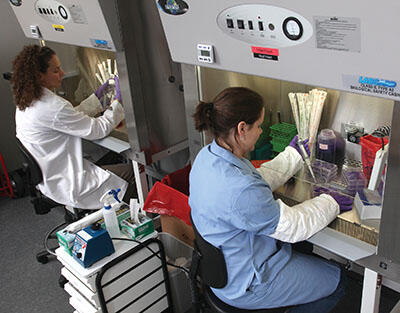
“We conducted a study to validate a modification EPA wanted to establish to a water sampling protocol,” said Senior Research Scientist Spring Cabiness. “Based on our participation and the participation of other labs nationwide, the method has now been validated and posted on the EPA Clean Water Act Analytical Methods page.”
The EPA started with an established method developed for smaller sample volumes, so the procedure required filtration techniques to concentrate the samples prior to evaluation. Samples were then prepped and poured into plates. After overnight incubation, scientists would assess contamination levels of the sampled water.
The SwRI team received an EPA letter of gratitude for helping characterize the performance of the methods and establish quality control acceptance criteria. Feedback allowed clarifications and revisions to be included with posted methods.
Seeing Past the Shine
SwRI in association with the open-source project ROS-Industrial developed a solution that enables industrial robots to scan and reconstruct metallic objects that had previously been too “shiny” for machine vision to process.
The solution for reconstructing shiny or featureless objects leverages an algorithm that pulls together many views of an object to create high-fidelity virtual representations of the to-be-processed object. SwRI showcased this approach using a second-generation Robot Operating System (ROS2) framework in an industrial demonstration system at the Automate 2019 trade show.
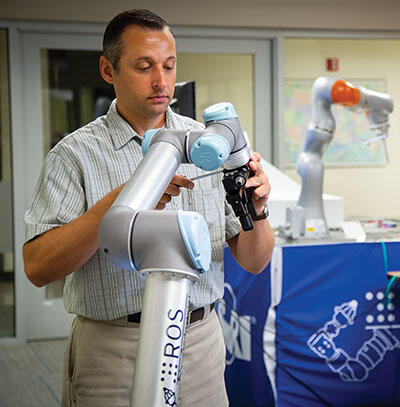
“This is a great case study in the benefits and challenges of integrating ROS2 into industrial robotics,” said Matt Robinson, an SwRI manager who supports ROS-I. “It also shows how advanced perception algorithms can enable faster, more reliable scanning of metallic objects.”
The latest ROS-I solution uses ROS2 to integrate cameras affixed to a robotic arm, collecting data at a high frame rate to create a 3D output mesh that optimizes path planning. Machine vision cameras and algorithms have historically struggled to render accurate 3D images of metallic objects due to the “visual noise” that scatters off highly reflective surfaces. This significant challenge limits automation of welding and surface finishing processes in aerospace and automotive manufacturing.
ROS-I overcomes this challenge by integrating algorithms that stitch together several images, or point clouds, at a higher rate. The solution uses TrajOpt, or trajectory optimization, for motion planning within the ROS-I Scan-N-Plan framework, enabling real-time trajectory planning from 3D scan data. Though demonstrated in ROS2, solutions are compatible in legacy ROS versions as well.
SwRI initiated the development of ROS-Industrial in 2012 through an SwRI internal research program conducted with industry collaborators. SwRI maintains the ROS-Industrial software repository and manages the ROS-Industrial Consortium (RIC).
Green Car Technology
SwRI’s automotive engineers are advancing connected and automated hybrid vehicle technologies with the goal of improving fuel economy by more than 20 percent.
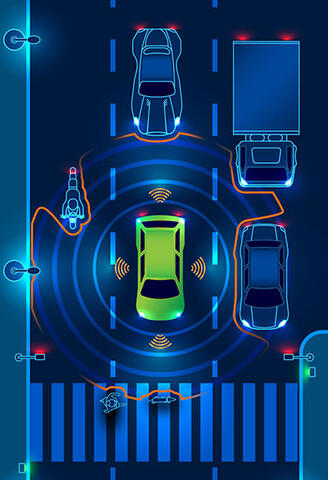
Working with the University of Michigan and Toyota Motor Corp., SwRI has developed control algorithms to optimize a hybrid vehicle’s route, speed profile and power flows. This real-time control is more efficient than dynamic cruise control and improves the power-split between battery and liquid fuel based on the preview of the road ahead, producing fuel savings in excess of 10 percent and up to 20 percent in certain scenarios.
Routes are optimized for both energy savings and arrival times. The technology uses existing applications such as Google Maps to preview the route ahead, including highway grade, stop signs, lights and traffic volume to choose the most energyefficient route. Integrated vehicle-to-vehicle (V2V) and vehicle-to-infrastructure (V2I) technology will help achieve maximum fuel economy.
The project is funded by the Advanced Research Projects Agency-Energy (ARPA-E) NEXTCAR program.
New Corrosion Facility
SwRI has launched a new facility to cost-efficiently conduct standardized corrosion testing for oil and gas clients. The facility evaluates the sulfide stress cracking resistance of carbon steel alloys for oil wells and offshore drilling applications.
“Previously, our laboratory work has been predominantly fit-for-purpose testing,” said SwRI’s Dr. Elizabeth Trillo, one of the leaders of the project. “Those tests simulate an environment with specific solutions, temperatures and pressures to evaluate materials used in specific drilling environments and determine whether they can withstand those conditions. Every test is different, but our specialty is catering to the client’s end-use need.”
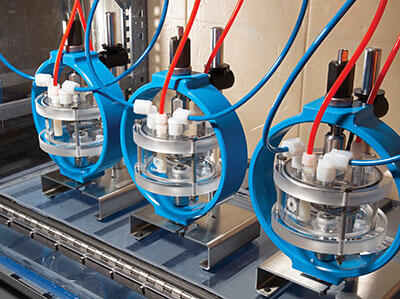
SwRI’s new facility houses multiple test cells allowing triplicate samples to be run within a customized glove box.
As a part of SwRI’s comprehensive oil and gas sour corrosion testing capabilities, the new facility is dedicated to cost-effective standardized testing to National Association of Corrosion Engineers TM0177. This test certifies carbon steel materials used in casings for down-hole drilling applications with high hydrogen sulfide levels. The casing is a large pipe inserted into the ground to protect equipment and support the well stream. It’s usually held in place with cement and endures massive pressures, high temperatures and corrosive liquids.
“We’ve typically designed new test methods that give us flexibility and control over individual environmental parameters,” said James Dante, manager of SwRI’s Environmental Performance of Materials Section. “In the new facility, we can perform repetitive testing in a cost-effective and repeatable manner while providing our clients with the same level of service they have experienced with more complex testing.”
Previously, a sample batch tested with several others might fail early in a 30-day test. Initiating a new test would disturb the other samples still under test. In the new facility, samples are evaluated in isolated test cells, giving SwRI the ability to change samples without disturbing other tests.
Results from NASA's OSIRIS-REx Mission
Watery Minerals on Bennu
An SwRI-led team discovered evidence of abundant water-bearing minerals on the surface of the near-Earth asteroid Bennu. Using early spectral data from NASA’s OSIRIS-REx spacecraft orbiting the asteroid, the team identified infrared properties similar to those in a type of meteorite called carbonaceous chondrites.
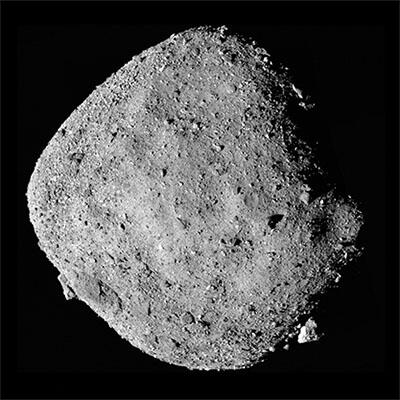
Courtesy of NASA/GSFC/University of Arizona
“Scientists are interested in the composition of Bennu because similar objects may have seeded the Earth with water and organic materials,” said SwRI’s Dr. Victoria Hamilton, a mission co-investigator, deputy instrument scientist, and lead author of a paper outlining the discovery published March 19 in Nature Astronomy. “OSIRIS-REx data confirm previous ground-based observations pointing to aqueously altered, hydrated minerals on the surface of the asteroid.”
Around 4.6 billion years ago, our solar system formed from the gravitational collapse of a giant nebular cloud. The Sun, planets and other objects such as asteroids and comets formed as materials within the collapsing cloud that clumped together in a process known as accretion. Carbonaceous chondrites, which come from asteroids, show evidence for post-accretion interactions of some asteroids with water and/or ice that led to chemical reactions that produce hydrated minerals. Because these meteorites and their asteroid parent bodies have remained unchanged since the earliest years of the solar system, they provide clues to the distribution, abundance and movements of water in the solar disk at that time.
“During planetary formation, scientists believe that water was one of many chemical components that accreted to form Earth. However, most scientists think additional water was delivered in part by comets and pieces of asteroids, including water-bearing carbonaceous meteorites,” Hamilton said. “Many of these meteorites also contain prebiotic organic chemicals and amino acids, which are precursors to the origin of life. The details of water delivery to Earth, as well as the larger issue of the different inventories of water ice in the early solar system, affect how we view solar system formation.”
Asteroid's Ancient Visage
An SwRI-led team has discovered that the surface geology on asteroid Bennu is older than expected. Early observations of the near-Earth asteroid (NEA) by NASA’s OSIRIS-REx mission indicate a surface that is between 100 million and 1 billion years old.
“We expected small, kilometer-sized NEAs to have young, frequently refreshed surfaces,” said SwRI’s Dr. Kevin Walsh, a mission co-investigator and lead author of a paper outlining the discovery published in Nature Geoscience.
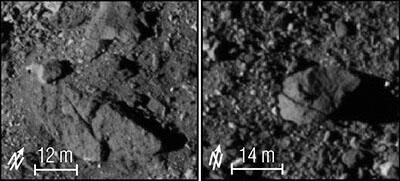
Courtesy of NASA/GSFC/University of Arizona
Using data from NASA’s OSIRIS-REx mission, an SwRI-led team discovered that the surface of near-Earth asteroid Bennu is geologically older than expected. Craters and large, often fractured boulders (shown here) likely date from the time the asteroid was still orbiting in the main asteroid belt between Mars and Jupiter.
“However, numerous large impact craters as well as very large, fractured boulders scattered across Bennu’s surface look ancient. We also see signs of some resurfacing taking place, indicating that the NEA retains very old features on its surface while still having some dynamic processes at play.”
The OSIRIS-REx spacecraft is visiting Bennu, a carbonaceous asteroid whose surface may record the earliest history of our solar system. Bennu was chosen based on its size, composition and proximity to Earth, passing nearby every six years. Its dusty regolith may contain molecular precursors to the origin of life and the Earth’s oceans.
Bennu is a “rubble pile” asteroid held together by its own gravity. Small rubble-pile asteroids likely formed in the main asteroid belt from debris accumulated following the breakup of a much larger asteroid. While in the main asteroid belt between Mars and Jupiter, these objects would be constantly bombarded by impactors, but once they leave the main belt and become NEAs, they are subject to further evolutionary processes.
“Both large craters and a widespread population of fractured boulders date back hundreds of millions of years to when Bennu was in the main asteroid belt,” Walsh said. “Meanwhile, we found signs of more recent surface movement, but it is either too localized or too infrequent to modify Bennu as much as expected. Maybe it hasn’t gotten close enough to a planet or the Sun to be modified on a large scale,” said Walsh.

